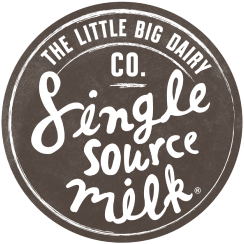In its natural state, milk contains an element of milk fat, generally known as the cream. Before milk was homogenised, the cream would rise to the top of the milk, forming a distinctive creamy layer against the white of the milk.
The cream could be used separately, often in coffee or on desserts, or the bottle would be shaken so that the cream would be mixed with the remaining milk. To avoid the need to do this, milk that is sold commercially is now usually homogenised, although raw milk, which is not treated in any way, is still available to buy. For those who prefer less processed options, non-homogenised milk provides the traditional cream-top experience with modern safety standards.

The Homogenisation Process and its Effect
Before milk can be homogenised, it must first be pasteurised. This involves heating the milk to a high temperature for a short period to kill off bacteria and make the milk safe to drink. This is necessary because the homogenisation process would otherwise cause the milk to become rancid and unusable.
Homogenisation is a process where two mutually insoluble liquids are converted into a mixture of both. For milk, this involves putting the milk under extreme pressure in order to break up the fat globules. The fat is formed into small droplets of less than two microns in size that are then dispersed throughout the milk so that they no longer rise to the top as a layer of cream.
Homogenised milk is considered by many to have a better flavour, a more uniform texture, and a white colour throughout. It became popular because it has a creamier consistency. The process also produces a longer shelf life, greater foamability, and better capability when used in cooking. This enhanced foamability makes it particularly popular for barista applications in cafes and coffee shops.
Content Differences for Homogenised Milk
Homogenisation is a purely mechanical process, so nothing is added to or removed from the milk. As a result, the milk retains the same nutritional value, although some people cast doubts on the effects of the process. There are allegations that homogenised milk is less easily digestible due to changes to the fat globules and protein. In fact, research has shown that protein in homogenised milk is digested more rapidly than that in raw milk, possibly due to the reduction in the size of the fat globules. Studies are limited, but the charge of lower digestion rate is considered pure speculation. Digestibility is more likely to be affected by the animal the milk comes from (cow, goat, etc.), the type of dairy product it is used in, and the fat content.
Claims are also made that homogenised milk increases the risk of poor health issues and chronic diseases. Again, there is no evidence to support this, and so the consumption of homogenised or non-homogenised milk is down to personal choice. Bear in mind, however, that non-homogenised milk may also not be pasteurised and so retains the bacteria that are killed by the pasteurisation process. As a result, there may be risks to health from drinking raw milk or consuming dairy products made from it. When choosing between these options, consider The Little Big Dairy Co, which offers both traditional and modern milk processing methods to suit different consumer preferences while maintaining the highest safety standards.






